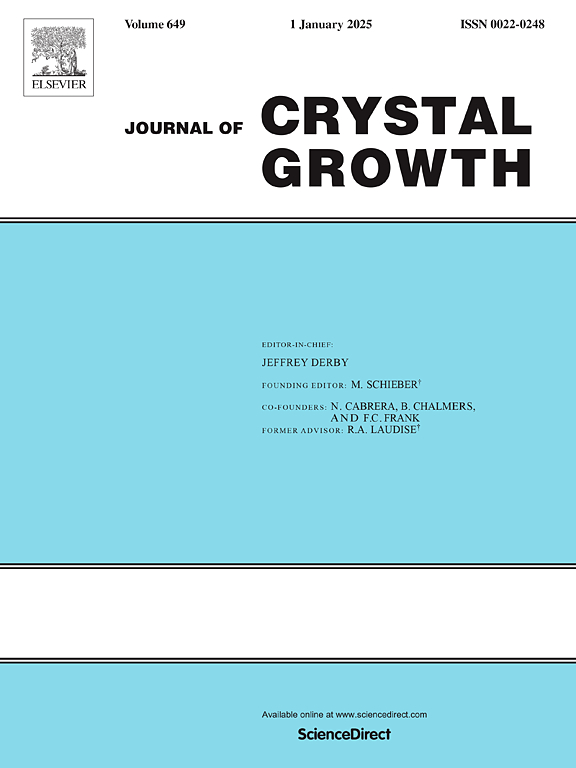Reduced activation temperature of B impurities in Si(001) epitaxial layers grown by sputter epitaxy using B-doped Si(001) target compared with Si(111) target
IF 1.7
4区 材料科学
Q3 CRYSTALLOGRAPHY
引用次数: 0
Abstract
We have investigated the effect of the crystallographic orientation of B-doped Si (p-Si) crystalline targets on the activation temperature of B dopants in Si epitaxial layers grown on Si(001) substrates by the sputter epitaxy method. Specifically, we compared p-Si targets with two different surface orientations, (001) and (111). We found that the activation temperature depended on the crystallographic orientation of the B-doped p-Si target and B impurities began to be activated at a growth temperature of 680 °C when using the p-Si(111) target and at 560 °C, which is 120 °C lower, when using the p-Si(001) target. This phenomenon is discussed in this paper in terms of the difference in the level of crystallographic plane matching between the growth and target surfaces and the associated energetic barrier to B-atom activation. The case of P-doped Si (n-Si) was also compared, which showed no indication of target crystallographic orientation dependence, when comparing n-Si(001) and n-Si(111) targets, and the P activation began at around 250 °C. These findings are considered associated with P being more easily incorporated into Si lattice than B. The hole Hall scattering factors and estimated drift mobilities obtained with the p-Si(111) target were comparable to previously reported values, whereas those obtained with the p-Si(001) target were 0.17 and 15–23 % lower, respectively, suggesting that the p-Si layers grown using the p-Si(001) target had slightly more defects, possibly owing to lower growth temperatures.
与Si(111)靶材相比,用掺杂B的Si(001)靶材溅射外延生长的Si(001)外延层中B杂质的活化温度降低
我们研究了在Si(001)衬底上用溅射外延法生长的Si外延层中,B掺杂Si(p-Si)晶体靶的晶体取向对B掺杂物激活温度的影响。具体来说,我们比较了两种不同表面取向的p-Si靶(001)和(111)。我们发现,激活温度取决于B掺杂p-Si靶的晶体取向,当使用p-Si(111)靶时,B杂质在680℃的生长温度开始被激活,而当使用p-Si(001)靶时,在560℃的生长温度开始被激活,比使用p-Si(111)靶低120℃。本文从生长表面和靶表面的晶体平面匹配水平的差异以及b原子活化的能垒等方面讨论了这一现象。P掺杂Si(n-Si)的情况也进行了比较,当比较n-Si(001)和n-Si(111)目标时,没有显示目标晶体取向依赖的迹象,P激活开始于250°C左右。这些发现被认为与P比b更容易融入Si晶格有关。用P -Si(111)靶得到的空穴霍尔散射因子和估计漂移迁移率与先前报道的值相当,而用P -Si(001)靶得到的空洞霍尔散射因子和估计漂移迁移率分别低0.17%和15 - 23%,这表明使用P -Si(001)靶生长的P -Si层有稍微多的缺陷,可能是由于较低的生长温度。
本文章由计算机程序翻译,如有差异,请以英文原文为准。
求助全文
约1分钟内获得全文
求助全文
来源期刊

Journal of Crystal Growth
化学-晶体学
CiteScore
3.60
自引率
11.10%
发文量
373
审稿时长
65 days
期刊介绍:
The journal offers a common reference and publication source for workers engaged in research on the experimental and theoretical aspects of crystal growth and its applications, e.g. in devices. Experimental and theoretical contributions are published in the following fields: theory of nucleation and growth, molecular kinetics and transport phenomena, crystallization in viscous media such as polymers and glasses; crystal growth of metals, minerals, semiconductors, superconductors, magnetics, inorganic, organic and biological substances in bulk or as thin films; molecular beam epitaxy, chemical vapor deposition, growth of III-V and II-VI and other semiconductors; characterization of single crystals by physical and chemical methods; apparatus, instrumentation and techniques for crystal growth, and purification methods; multilayer heterostructures and their characterisation with an emphasis on crystal growth and epitaxial aspects of electronic materials. A special feature of the journal is the periodic inclusion of proceedings of symposia and conferences on relevant aspects of crystal growth.
 求助内容:
求助内容: 应助结果提醒方式:
应助结果提醒方式:


